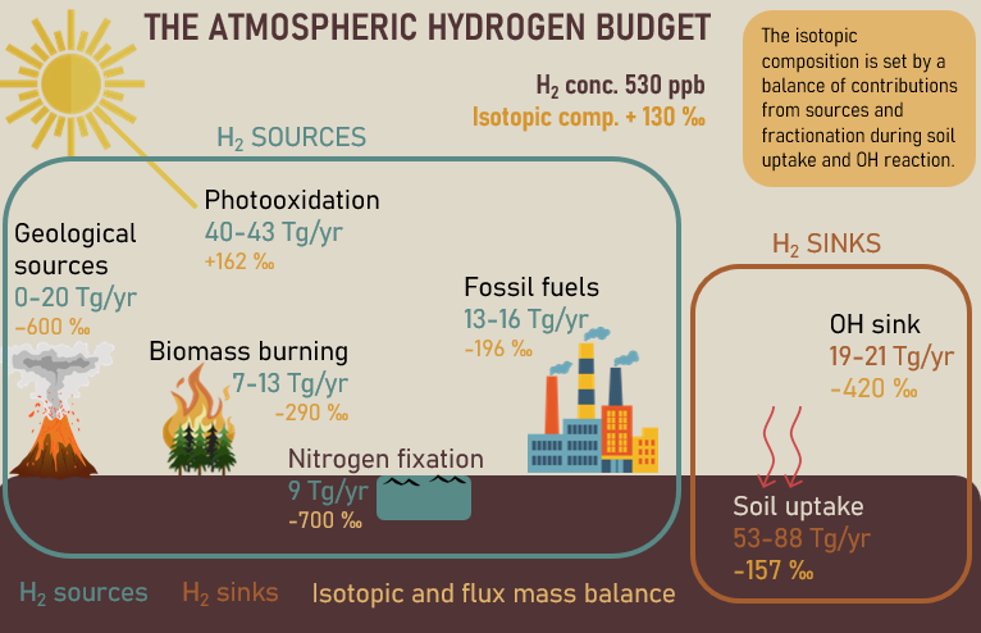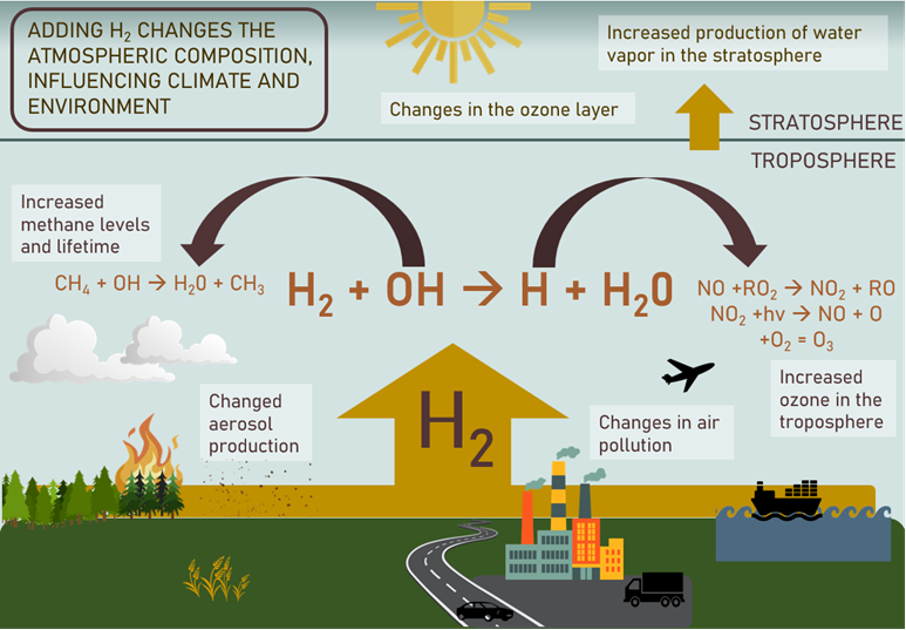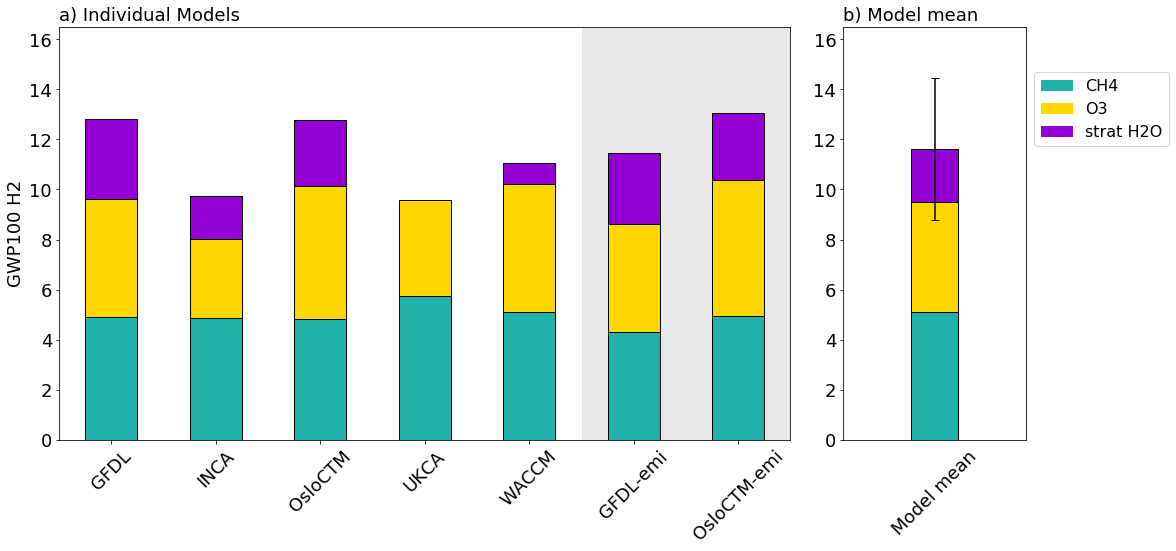Minimizing hydrogen leakages key in future hydrogen economy
Published in Earth & Environment

Hydrogen has received increasing global interest as a replacement for fossil fuels and a potential for significant reductions in CO2 emissions. The net displacement of fossil fuels depends strongly on how the hydrogen is produced. Hydrogen is currently produced almost entirely from fossil fuels (grey hydrogen), with 6% of global natural gas and 2% of global coal going to hydrogen production. It is therefore green hydrogen produced from renewables and blue hydrogen produced from fossil fuels combined with carbon capture and storage, that play a key role in future energy scenarios compatible with the Paris Agreement targets.
However, even if hydrogen is produced from renewables, hydrogen can lead to global warming. Why? Unlike exhaust from the burning of coal and gas that consist of CO2, the burning of hydrogen emits only water vapour and oxygen. Rather it is the leaking of hydrogen from production, transportation and usage that adds to the global warming. Hydrogen is not a greenhouse gas, but its chemical reactions in the atmosphere in turn affect greenhouse gases like methane, ozone, and stratospheric water vapour. In this way emissions of hydrogen can cause global warming, despite its lack of direct radiative properties.
The hydrogen budget in the atmosphere
Hydrogen stays in the atmosphere for about 2 years and is removed by two main sinks: soil uptake and oxidation by OH (Fig 1) . The largest sink term is soil removal, which can account for as much as 80% of the loss of hydrogen.

The reaction of hydrogen with OH influences the lifetime of methane, leading to a longer methane lifetime as global hydrogen mixing ratios increase (Fig 2). Moreover, hydrogen oxidation leads to an increase in ozone production in the troposphere, especially in a NOx-rich environment. Meanwhile, the water vapour produced from the oxidation of hydrogen can persist in the stratosphere due to a much longer lifetime than in the troposphere, thus causing additional radiative forcing.

How this study was initiated
Three and a half years ago, Equinor, Norway’s largest oil and gas company, contacted CICERO to learn about the climate impacts of hydrogen emissions. Their biggest concern was the water vapor production and how this could influence global warming. In response to the request from Equinor, our group at CICERO conducted a literature review report of current knowledge of the climate impacts of hydrogen and was successfully granted funding for a project (HYDROGEN) to conduct further research on the subject from the Research Council of Norway and hydrogen industry partners. In establishing the HYDROGEN proposal, it was important to involve other modelling groups given the complex atmospheric chemistry associated with hydrogen and we involved modelling groups in the UK, France and the US. The industry partners were interested in a better estimate of the Global Warming Potential (GWP100) of hydrogen. GWP100 is a widely used, policy relevant metric, because it allow comparison of the climate impacts of emissions of different gases. GWP100 is a measure of the perturbation to the top-of-the-atmosphere radiative energy budget integrated over 100 years, caused by emissions of a gas (in this case hydrogen), relative to that caused by emissions of the same mass of CO2. If this number for hydrogen turned out to be large, the industry partners needed to take this into account when planning for a future hydrogen economy and leakage detection.
Global warming potential of hydrogen
In this study we used five different global atmospheric chemistry models (GFDL, OsloCTM, INCA, WACCM and UKCA). We calculated GWP100 using a steady-state perturbation approach that takes all effects of atmospheric hydrogen into account in a comprehensive way.

Figure 3: Hydrogen GWP100 for the individual models (a) and model mean (b), split into contributions from methane (green), ozone (yellow) and stratospheric water vapor (purple). The UKCA model only includes tropospheric changes. The uncertainty range in (b) is calculated using the model mean and spread in underlying values found in literature and the model ensemble spread.
Figure 3 shows the hydrogen GWP100 values for all models, split into the contribution from methane, ozone, and stratospheric water vapor. The model mean hydrogen GWP100 is 11.6±2.8 (one standard deviation). The largest contribution is from changes in methane (44%), followed by ozone (38%) and stratospheric water vapor (18%). The uncertainty range covers soil uptake, photochemical production of hydrogen, the lifetimes of hydrogen and methane, and the OH feedback on methane and hydrogen. The number 11.6±2.8 (one standard deviation) is comparable to the single-model studies of Warwick et al (2023) (12±6) and Hauglustaine et al. (2022) (12.8±5.2, 90 % confidence interval), but twice as high as previously published numbers (Derwent et al., 2020) which did not consider changes in the stratosphere.
Implications
Our estimated GWP100 of hydrogen is almost 40% of that to fossil fuel methane GWP100 in IPCC AR6. The potential benefit of switching to a hydrogen economy will depend on how large the hydrogen leakages are, and what hydrogen replaces, i.e. the potential reductions in CO2 emissions and co-emitted species. Various assumptions and estimates of hydrogen leakages vary from 1-10% depending on how hydrogen is being produced, transported, and stored (Frazer-Nash Consultancy, 2022; van Ruijven et al., 2011). The little data that exists on hydrogen leakages comes from assessments and simulations rather than direct measures.
Hydrogen leakages will lead to global warming, and it will be important to keep these leakages at a minimum to accomplish the benefits of switching to a hydrogen economy. Therefore, there is a great need to develop instruments for leakage detection for monitoring, so we can get a better picture of how large these leakages are today.
References:
- Derwent, R. G., et al. Global modelling studies of hydrogen and its isotopomers using STOCHEM-CRI: Likely radiative forcing consequences of a future hydrogen economy. Intl. J. of Hydrogen Energy, 45, 9211-9221, (2020).
- Frazer-Nash Consultancy, Fugitive Hydrogen Emissions in a Future Hydrogen Economy. Technical Report (2002).
- Hauglustaine, D. et al. Climate benefit of a future hydrogen economy. Communications Earth & Environment, 3, doi:10.1038/s43247-022-00626-z (2022).
- van Ruijven, B., et al. Emission scenarios for a global hydrogen economy and the consequences for global air pollution. Global Environmental Change, 21, 983-994 (2011).
- Warwick, N.J. et al. Atmospheric composition and climate impacts of a future hydrogen economy. Atmospheric Chemistry and Physics Discussions, doi: 10.5194/acp-2023-29 (2023).
Follow the Topic
-
Communications Earth & Environment

An open access journal from Nature Portfolio that publishes high-quality research, reviews and commentary in the Earth, environmental and planetary sciences.
Related Collections
With Collections, you can get published faster and increase your visibility.
Geology of the Moon
Publishing Model: Hybrid
Deadline: Jan 31, 2026
Drought
Publishing Model: Hybrid
Deadline: Dec 31, 2025

Please sign in or register for FREE
If you are a registered user on Research Communities by Springer Nature, please sign in